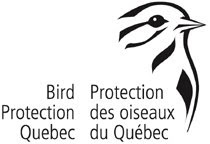A pleasantly sunny start to the day turned into near 30degC temperatures by noon when we finished but once inside the forest the cool shade was very pleasant – and the mosquitoes were really not too bad at all.
Starting at the old station in Prévost we walked the well graded gravel “road” of the Petit train du nord though mixed woodland containing plenty of singing warblers etc before branching off towards the cliffs where we I had encouraged people to believe that we would see Peregrine falcons. A week ago while scouting the area in preparation for this trip we had seen Peregrines flying above the cliffs and managed to grab a distant and fuzzy photograph. A few days later we learned that the local birders who have been monitoring them for some weeks since they returned in the spring hadfinally managed to find the nest and on showing them the picture I was told (thanks Réjean) “… le nid des Faucons pélerin se trouover sur la falaise à l’extrème gauche de la photo“. That seemed pretty clear and so, suitably encouraged and with fingers crossed, I suggested that everyone line up on the trail, point scopes at the cliff and get scanning for the nest.
Twenty minutes later, somewhat chastened, we folded our scopes away with neither sight nor sound of the Peregrines and headed deeper into the forest where we passed to the east side of Lac Paradis and continued up the slopes towards the hydro-power lines that cut through the trees. A nice collection of birds was gathered before we turned back and descended towards the lake which this time we passed by the opposite shore.
Half way along this shore is a turning to the left which forms a new, well marked, but somewhat precipitous at times trail through the forest back towards the cars. About half the group decided that they would like to investigate this and so we divided into two groups and agreed to meet at the station around noon. The fit explorers zoomed into the forest while the rest of thought we would “have another look at the cliff”… where almost immediately after setting up our scopes we saw first one and then two Peregrines and shortly after located the nest with two chicks in it. I must say they have picked a particularly well-favoured spot for the nest, a slight backwards slope from the edge, judiciously placed stones to mitigate winds and rain and a small bush growing in a crack above it to provide shade. Clearly these are parent birds who know what they are about.
I feel a little bad about this, as after having suggested people might like to try the alternate trail those who took up the idea thereby missed the Peregrine by being so adventurous. I hereby apologise – and also I thank them for being gracious about it when we met up again and started crowing about our good fortune. The alternate party smiled, nodded, said congratulations and noted that they had enjoyed their trail … but they missed the Falcons. Of course, this just gives them a good excuse to go back by themselves … it’s always worth the journey up there.
The birds we saw amounted to the following 36 species … after you have read though the list of species there are some photographs for you and a short video of the Peregrine on its nest with two chicks.
Canada Goose 50 – Wood Duck 2 – Mallard 2 – Great Blue Heron 1 – Turkey Vulture 3- Red-shouldered Hawk 1 – Ruby-throated Hummingbird 1 – Belted Kingfisher 1 – Yellow-bellied Sapsucker 1 – Downy Woodpecker 1 – Hairy Woodpecker 1 – Pileated- Woodpecker 1 – Peregrine Falcon 2 – Alder Flycatcher 1 – Red-eyed Vireo 10 – Blue Jay 6 – American Crow 6 – Black-capped Chickadee 15 – Winter Wren 2 - Veery 4 – American Robin 1 – Cedar Waxwing 12 – Ovenbird 8 – Black-and-white Warbler 4 – Common Yellowthroat 4 – Magnolia Warbler 1 – Blackburnian Warbler 1 – Chestnut-sided Warbler 3 – Black-throated Blue Warbler 2 – Black-throated Green Warbler 7 – Song Sparrow 2 – Scarlet Tanager 1 – Indigo Bunting 1 – Common Grackle 3 – American Goldfinch 12 - Mourning dove1
Bernache du Canada 50 - Canard branchu 2 - Canard colvert 2 - Grand Héron 1 - Urubu à tête rouge 3 - Buse à épaulettes 1 - Colibri à gorge rubis 1 - Martin-pêcheur 1 - Pic maculé 1 - Pic mineur 1 - Pic chevelu 1 - grand pic- 1 - Faucon pèlerin 2 - Moucherolle des aulnes 1 - Viréo aux yeux rouges 10 - Geai bleu 6 - Corneille d'Amérique 6 - Mésange à tête noire 15 - Troglodyte mignon 2 - Grive fauve 4 - Merle d'Amérique 1 - Jaseur d'Amérique 12 - Paruline couronnée 8 - Paruline Noir et blanc 4 - Paruline masquée 4 - Paruline à tête cendrée 1 - Paruline à gorge orangée 1 - Paruline à flancs marron 3 - Paruline bleue 2 - Paruline à gorge noire7 - Bruant chanteur 2 - Tangara écarlate 1 - Passerin indigo 1 - Quiscale bronzé 3 - Chardonneret jaune 12 - Touterelle triste 1





No comments:
Post a Comment